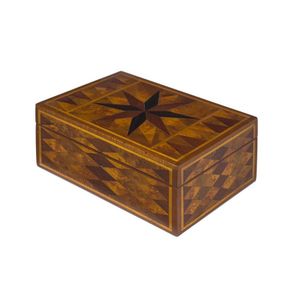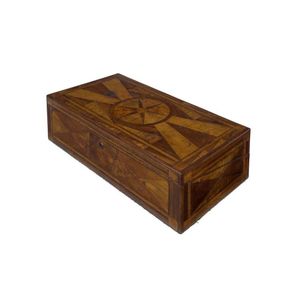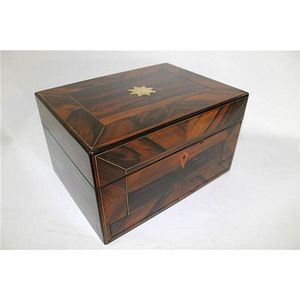Australian Timber Inlaid Box with Sunburst Lid and Tumbling Design
You must be a subscriber, and be logged in to view price and dealer details.
Subscribe Now to view actual auction price for this item
When you subscribe, you have the option of setting the currency in which to display prices to $Au, $US, $NZ or Stg.
- Blackwood - One of the best known and most widely used Australian timbers, blackwood (acacia melanoxylon), is a member of the Acacia (wattle) family and grows in eastern Australia from about Adelaide in South Australia, as far north as Cairns in Queensland.
The largest, straightest and tallest trees come from the wet forest and swamps of north-west Tasmania where it is grown commercially.
Blackwood timber colours range across a wide spectrum, from a very pale honey colour through to a dark chocolate with streaks of red tinge.
The hardwood timber has been commonly used in the production of furniture, flooring, and musical instruments in Australia from the late 19th century. However, the straight grain timber is not the most prized or valuable, that honour falls to blackwood with a wavy, fiddleback pattern, which is used both in the solid and as a veneer. Fiddleback was only used on the finest examples of furniture. - Huon Pine - Named after the Frenchman who discovered the Huon River in Tasmania, it is an extremely slow growing and long living tree. Huon pine is native to Tasmania, and it can grow to an age of 3,000 years or more. The wood contains oil that retards the growth of fungi, hence its early popularity in ship-building in convict-era Tasmania. The timber is a warm yellow colour, finely grained, and was popular for household furniture in the Victorian era. Interestingly, much Huon pine furniture was made in South Australia. Huon pine is a protected species and only limited quantities are available nowadays, for craftsmen to manufacture small items such as platters, sculptures and other decorative objects.
- Kauri - An evergreen conifer tree associated with New Zealand, but also grown in northern Australia, and islands around the Pacific rim including Borneo, Vanuatu and New Guinea. The timber is generally golden in colour, and straight grained without much knotting.
A by-product of the kauri tree was the kauri gum, the fossilised resin extracted from the tree. The gum was obtained through digging, fossicking in treetops, or more drastically, by bleeding live trees. Kauri gum was used in the manufacture of varnishes and other resin-based products, and also crafted into jewellery, keepsakes, and small decorative items.
Kauri forests were prolific in the north of the North Island of New Zealand. European settlers in the 1700 and 1800s realised that the timber from these tall trees with broad trunks would be ideal for ship building and construction and a thriving industry was established harvesting the kauri tree. The forests were substantially reduced, and now the remaining Kauri trees that grow in New Zealand are protected, and there are reserves in various areas of the North Island.
The remaining stands of kauri in New Zealand are under threat from "kauri disease", a microscopic organism that causes dieback in the trees, with vast tracts either dead or dying.
This item has been included into following indexes:
- boxes, material or decoration
Visually similar items

A fine Tasmanian work box, huon pine, musk, casuarina, blackwood, pine and dogwood, fitted huon pine interior with whalebone handles, circa 1850, 12.5 cm high, 30 cm wide, 20.5 cm deep

A superb Tasmanian timber writing box, huon pine, musk, cedar, blackwood, myrtle, beefwood, honeysuckle and casuarina, cedar secondary timbers, fitted with slope and drawer compartments, circa 1850, 18 cm high, 61 cm wide, 31 cm deep

A Victorian coromandel and brass inlaid casket with hinged cover and with a drawer with concealed mechanism. Width 30 cm

Victorian glove box, with fiddle grain and decorative inlay, 25 cm x 13 cm, 9.5 cm high
